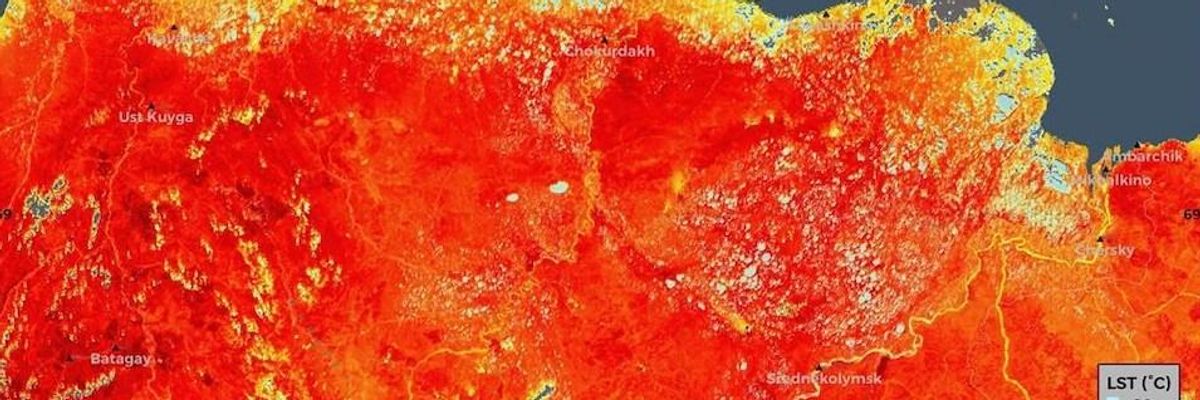
This photo taken on Friday, June 19, 2020 and provided by ECMWF Copernicus Climate Change Service shows the land surface temperature in the Siberia region of Russia. (Image: ECMWF Copernicus Climate Change Service/AP)
'Warning Sign of Major Proportions': Number of Siberian Forest Fires Increase Fivefold in Week Since Record High Temperature
"The Arctic is figuratively and literally on fire."
The number of fires in the vast north Asian region of Siberia increased fivefold this week, according to the Russian forest fire aerial protection service, as temperatures in the Arctic continued higher than normal in the latest sign of the ongoing climate crisis.
The news of the increase comes a week after the small Siberian town of Verkhoyansk reported a high temperature of 100.4deg F on June 20, a reading that, if confirmed, would mark the hottest day ever recorded in the region.
"While fires are common at this time of year, record temperatures and strong winds are making the situation particularly worrying," the European Union's Earth Observation Programme, which is monitoring the situation, said in a statement.
\u201cA record heatwave in Siberia has led to forest fires in the Republic of Sakha.\n\nTemperatures spiked to 30C (86F) on Wednesday\u201d— Shakthi \ud83c\uddee\ud83c\uddf3 (@Shakthi \ud83c\uddee\ud83c\uddf3) 1593126280
As the Associated Press reported:
According to figures reported Saturday by Avialesookhrana, Russia's agency for aerial forest fire management, 1.15 million hectares (2.85 million acres) were burning in Siberia in areas that cannot be reached by firefighters.
The worst-hit area is the Sakha Republic, where Verkhoyansk is located, with 929,000 hectares (2.295 million acres) burning.
The Sakha Republic's fire service reported 127 natural fires in the Russian federal sector.
The fires and heat are due to the climate crisis, Weather Channel meteorologist Carl Parker told Newsweek.
"What climate change is doing is moving the distribution of weather events, such that historically low-frequency, extreme events occur more frequently," said Parker. "Had the climate not changed due to man-made greenhouse gases, the heat we've seen in parts of Siberia would have been a 100,000-year event."
Parker warned that the fires are part of a dangerous feedback loop in the northern region.
"What's scary about the warming in Siberia is that there are huge quantities of carbon in permafrost, which can be unleashed during periods like this, particularly as fires develop in the region," said Parker.
\u201cThe situation is getting much worse in Siberia.. #WeDontHaveTime \n\nhttps://t.co/XZ3EN1WueB\u201d— We Don't Have Time (@We Don't Have Time) 1593283448
Jonathan Overpeck, University of Michigan environmental school dean, told AP in an email on June 24 that the situation in the Arctic region is unprecedented.
"The Arctic is figuratively and literally on fire," wrote Overpeck. "It's warming much faster than we thought it would in response to rising levels of carbon dioxide and other greenhouse gases in the atmosphere, and this warming is leading to a rapid meltdown and increase in wildfires."
"The record warming in Siberia is a warning sign of major proportions," he added.
Temperatures in Siberia for the first five months of 2020 were an average 14deg F over normal.
"That's much, much warmer than it's ever been over that region in that period of time," Zeke Hausfather, a Berkeley Earth climate scientist, told AP.
An Urgent Message From Our Co-Founder
Dear Common Dreams reader, The U.S. is on a fast track to authoritarianism like nothing I've ever seen. Meanwhile, corporate news outlets are utterly capitulating to Trump, twisting their coverage to avoid drawing his ire while lining up to stuff cash in his pockets. That's why I believe that Common Dreams is doing the best and most consequential reporting that we've ever done. Our small but mighty team is a progressive reporting powerhouse, covering the news every day that the corporate media never will. Our mission has always been simple: To inform. To inspire. And to ignite change for the common good. Now here's the key piece that I want all our readers to understand: None of this would be possible without your financial support. That's not just some fundraising cliche. It's the absolute and literal truth. We don't accept corporate advertising and never will. We don't have a paywall because we don't think people should be blocked from critical news based on their ability to pay. Everything we do is funded by the donations of readers like you. Will you donate now to help power the nonprofit, independent reporting of Common Dreams? Thank you for being a vital member of our community. Together, we can keep independent journalism alive when it’s needed most. - Craig Brown, Co-founder |
The number of fires in the vast north Asian region of Siberia increased fivefold this week, according to the Russian forest fire aerial protection service, as temperatures in the Arctic continued higher than normal in the latest sign of the ongoing climate crisis.
The news of the increase comes a week after the small Siberian town of Verkhoyansk reported a high temperature of 100.4deg F on June 20, a reading that, if confirmed, would mark the hottest day ever recorded in the region.
"While fires are common at this time of year, record temperatures and strong winds are making the situation particularly worrying," the European Union's Earth Observation Programme, which is monitoring the situation, said in a statement.
\u201cA record heatwave in Siberia has led to forest fires in the Republic of Sakha.\n\nTemperatures spiked to 30C (86F) on Wednesday\u201d— Shakthi \ud83c\uddee\ud83c\uddf3 (@Shakthi \ud83c\uddee\ud83c\uddf3) 1593126280
As the Associated Press reported:
According to figures reported Saturday by Avialesookhrana, Russia's agency for aerial forest fire management, 1.15 million hectares (2.85 million acres) were burning in Siberia in areas that cannot be reached by firefighters.
The worst-hit area is the Sakha Republic, where Verkhoyansk is located, with 929,000 hectares (2.295 million acres) burning.
The Sakha Republic's fire service reported 127 natural fires in the Russian federal sector.
The fires and heat are due to the climate crisis, Weather Channel meteorologist Carl Parker told Newsweek.
"What climate change is doing is moving the distribution of weather events, such that historically low-frequency, extreme events occur more frequently," said Parker. "Had the climate not changed due to man-made greenhouse gases, the heat we've seen in parts of Siberia would have been a 100,000-year event."
Parker warned that the fires are part of a dangerous feedback loop in the northern region.
"What's scary about the warming in Siberia is that there are huge quantities of carbon in permafrost, which can be unleashed during periods like this, particularly as fires develop in the region," said Parker.
\u201cThe situation is getting much worse in Siberia.. #WeDontHaveTime \n\nhttps://t.co/XZ3EN1WueB\u201d— We Don't Have Time (@We Don't Have Time) 1593283448
Jonathan Overpeck, University of Michigan environmental school dean, told AP in an email on June 24 that the situation in the Arctic region is unprecedented.
"The Arctic is figuratively and literally on fire," wrote Overpeck. "It's warming much faster than we thought it would in response to rising levels of carbon dioxide and other greenhouse gases in the atmosphere, and this warming is leading to a rapid meltdown and increase in wildfires."
"The record warming in Siberia is a warning sign of major proportions," he added.
Temperatures in Siberia for the first five months of 2020 were an average 14deg F over normal.
"That's much, much warmer than it's ever been over that region in that period of time," Zeke Hausfather, a Berkeley Earth climate scientist, told AP.
The number of fires in the vast north Asian region of Siberia increased fivefold this week, according to the Russian forest fire aerial protection service, as temperatures in the Arctic continued higher than normal in the latest sign of the ongoing climate crisis.
The news of the increase comes a week after the small Siberian town of Verkhoyansk reported a high temperature of 100.4deg F on June 20, a reading that, if confirmed, would mark the hottest day ever recorded in the region.
"While fires are common at this time of year, record temperatures and strong winds are making the situation particularly worrying," the European Union's Earth Observation Programme, which is monitoring the situation, said in a statement.
\u201cA record heatwave in Siberia has led to forest fires in the Republic of Sakha.\n\nTemperatures spiked to 30C (86F) on Wednesday\u201d— Shakthi \ud83c\uddee\ud83c\uddf3 (@Shakthi \ud83c\uddee\ud83c\uddf3) 1593126280
As the Associated Press reported:
According to figures reported Saturday by Avialesookhrana, Russia's agency for aerial forest fire management, 1.15 million hectares (2.85 million acres) were burning in Siberia in areas that cannot be reached by firefighters.
The worst-hit area is the Sakha Republic, where Verkhoyansk is located, with 929,000 hectares (2.295 million acres) burning.
The Sakha Republic's fire service reported 127 natural fires in the Russian federal sector.
The fires and heat are due to the climate crisis, Weather Channel meteorologist Carl Parker told Newsweek.
"What climate change is doing is moving the distribution of weather events, such that historically low-frequency, extreme events occur more frequently," said Parker. "Had the climate not changed due to man-made greenhouse gases, the heat we've seen in parts of Siberia would have been a 100,000-year event."
Parker warned that the fires are part of a dangerous feedback loop in the northern region.
"What's scary about the warming in Siberia is that there are huge quantities of carbon in permafrost, which can be unleashed during periods like this, particularly as fires develop in the region," said Parker.
\u201cThe situation is getting much worse in Siberia.. #WeDontHaveTime \n\nhttps://t.co/XZ3EN1WueB\u201d— We Don't Have Time (@We Don't Have Time) 1593283448
Jonathan Overpeck, University of Michigan environmental school dean, told AP in an email on June 24 that the situation in the Arctic region is unprecedented.
"The Arctic is figuratively and literally on fire," wrote Overpeck. "It's warming much faster than we thought it would in response to rising levels of carbon dioxide and other greenhouse gases in the atmosphere, and this warming is leading to a rapid meltdown and increase in wildfires."
"The record warming in Siberia is a warning sign of major proportions," he added.
Temperatures in Siberia for the first five months of 2020 were an average 14deg F over normal.
"That's much, much warmer than it's ever been over that region in that period of time," Zeke Hausfather, a Berkeley Earth climate scientist, told AP.

